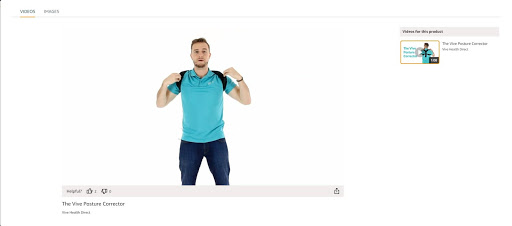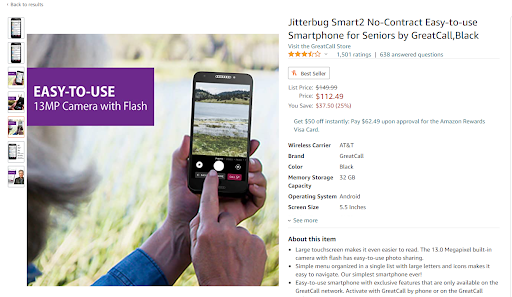Thanks to Jake Rheude of Red Stag Fulfillment for this guest post on how baby boomer marketing can help drive traffic to your Amazon store.
Let’s not pretend that 2020 was sunshine and daisies; it sucked. But from an economic perspective, it catalyzed the transition from retail to e-commerce, by some estimates squeezing up to 10 years’ worth of growth and adoption into those first few critical lockdown months.
Millennials and Gen X consumers preferred e-commerce over in-store shopping long before COVID-19 was a thing, and now it appears baby boomers are following their lead. A few months into the pandemic, more than half of baby boomers said they were spending more money online.
Now that boomers are becoming more comfortable with e-commerce, it’s time for retailers, and Amazon sellers in particular, to reevaluate the online shopping experience with a focus on baby boomer marketing.
Here are five ways to make your store more appealing to boomers. Some of these are exclusive to Amazon, but they are all worth considering wherever you engage with the 55-and-older demographic online.
1. Make sure your Amazon store is Prime
This tip is the most obvious and the most important. Shoppers, especially baby boomers, love free shipping, which is one perk of being an Amazon Prime member.
Not surprisingly, Amazon Prime memberships in the U.S. increased dramatically across all age groups during the initial lockdown phase of 2020. Boomers virtually kept pace with millennials, who make up the bulk of Prime members.
If there’s only one thing you do to make your Amazon store more attractive to boomers, it’s to become a Prime seller (if you’re not already, of course). Sign up for Fulfillment by Amazon or with a third-party logistics provider for Seller Fulfilled Prime.
2. Use video demonstrations and 360-degree product imagery
Boomers prefer in-store shopping more than any other demographic. It stands to reason that an online shopping experience will be more attractive to them if you emulate in-store shopping as much as possible.
Two ways to do this in your Amazon store are with video demonstrations and 360-degree product imagery. Both emulate the visual aspects of shopping in person. It’s one thing to look at a two-dimensional product photo, and another to see that same product rendered from all sides. For someone who wants to “try it before they buy it,” a video demo may help them better understand the product and feel confident they’re buying something of value.
One example of a store that uses video to its advantage is Vive, which sells physical therapy aids and other products geared toward older populations. Vive produces a series of simple educational videos explaining how to use its products like this shoulder brace:
There’s another reason to beef up the visual offerings of your Amazon store. As boomers age, they’re likely to experience issues such as macular degeneration, glaucoma, and hearing loss.
Amazon has made strides when it comes to accessibility, but adding narrated video and product descriptions, zoomed-in photos, and 360-degree photography will make shoppers with vision or hearing issues feel even more comfortable in your store.
3. Use models who are baby boomers themselves
People are more likely to relate to a product or service if they see someone who looks like them using it. Think about how this applies to the way you market your products on Amazon. If you cater to older customers, it might be helpful to include product photos of models who appear to be around the age of your target audience.
Take a look at GreatCall, an electronics company that makes phones and medical alert devices for older consumers. The product photos in their store feature models who are middle-aged or older, most with gray hair and wrinkles.
In the product shot below of GreatCall’s Jitterbug smartphone, you see the veined hands of a female model and, in the blurred foreground, her gray hair.
It would be less realistic if GreatCall were to feature a younger model using one of its devices. That isn’t to say there aren’t young people who may use and benefit from its products. But the majority of GreatCall’s customers probably appreciate the use of models who resemble them.
4. Use language that conveys ease of use
No one, young or old, likes to read instruction manuals. (The Washington Post chronicled this decades ago and it still holds true.) And few shoppers, especially boomers, welcome the thought of having trouble operating a new product they just bought. It’s important that you sell them on the idea that what they’re buying will work the moment they take it out of the box.
Words that convey simplicity, such as easy, quick, instant, and simple, are your friends here. GreatCall, the company we mentioned earlier, uses the phrase easy-to-use in its product names and descriptions.
Of course, don’t forget to design a product that’s actually easy to use!
5. Answer every question
You should do this no matter which demographic you cater to. When an Amazon customer has a question about a product, answer it!
While Amazon says customers can expect a seller to respond within two days, the sooner you reply back, the fresher the experience will be in your customer’s head. For boomers making the decision to buy from you, getting the information they need as soon as possible will give them peace of mind.
Baby boomer marketing: key takeaways
When it comes to making your Amazon store more appealing to baby boomers, don’t overthink it. As you can see from these five tips, how you market and sell to boomers should reflect Amazon’s mission: to be the most convenient online store on Earth.
If you take that to heart and center your customer in everything you do, you’ll set yourself up for success as an Amazon seller.
Jake Rheude is vice president of marketing for Red Stag Fulfillment, an e-commerce fulfillment warehouse born out of e-commerce. He has years of experience in e-commerce and business development. In his free time, Jake enjoys reading about business and sharing his own experience with others.





